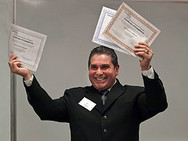Can job training work?

Photo by Michael @ NW Lens on Flickr.
One of Mayor-elect Gray’s top priorities is improving job training to reduce unemployment that has reached crisis levels in Wards 7 and 8. Gray will hold a Jobs Summit on Dec 13 to gather ideas on training.
Momentum appears to be building for greater investments in training. Councilmember Marion Barry’s proposal to cut off TANF benefits after 5 years presumes such a boost in training.
And massive job training is often viewed as the only possible hedge against displacement of long-term working-class residents as gentrification continues across the city.
But does training work? Or could training simply end up costing DC far more than the money it would save by cutting 17,000 families off of welfare?
There is a real debate about the effectiveness of public investment in job training. The debate generally proceeds as follows.
Training Doesn’t Work: The millions that have been spent on training in the American Recovery and Reinvestment Act, as was shown by the Labor Department and the NY Times, have demonstrated zero results. It makes us feel better, but the data shows that recipients of publicly subsidized training end up pretty much like they did before the training.
Training Works: This criticism is true in general. Many, perhaps most, training programs have been poorly executed. But studies, such as a recent study from Public/Private Ventures, have shown that training programs that target high-demand jobs in a city’s growth sectors do work.
Training Doesn’t Work: Not if the jobs simply aren’t there. Training doesn’t create jobs.
Training Works: No, but training does close the mismatch between the skills required by high-demand jobs and the skills of the unemployed. And employers in high-growth fields report that they are having trouble filling lots of positions due to precisely this mismatch.
Furthermore, if we can create a workforce whose skills do match the needs of high-growth fields, employers will be attracted to DC and will create more jobs. So, training can create jobs in the long term if it targets high-demand jobs that employers have difficultly filling.
Training Doesn’t Work: This sounds great. But the mismatch between the skills of most unemployed and the needs of the labor market, particularly in DC, is sadly too great for training to bridge.
More than 40% of jobs in DC require a college degree, while nationally only 20-22% of jobs require a college degree. Yet 36% of DC residents are functionally illiterate.
Approximately 18,000 TANF recipients have less than a high school credential and almost 50% are reading below 7th grade. What training does Councilmember Barry expect will match these 18,000 TANF recipients with the jobs that exist in DC?
What do you think? Can job training work? Is the skills mismatch sadly too great to bridge? What implications do these considerations have for Gray’s job training plans?
Gray’s Jobs Summit, which will be chaired by Barbara Lang, president of the D.C. Chamber of Commerce, and Josyln Williams, head of the Metropolitan Council of the AFL-CIO, should address these difficult questions head on.
